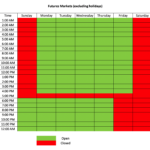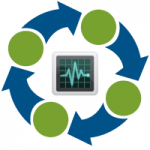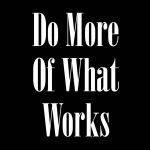Futures contracts are a type of forward contract between a buyer and a seller of an asset, usually commodities like corn, gold, or oil, but it can also be other kinds of assets such as a market index, like the S&P 500 or Dow, it can even be financial instruments like 30 year treasuries.
There are two types of buyers and sellers of futures, those in the cash markets (the business) of the respective commodity who want to protect themselves from price volatility, and speculators or investors who try to profit from the change in price of an asset.
If you are reading this, odds are that you are a speculator, looking to profit from the change in price of the many kinds of futures that represent various kinds of commodities.
Futures Contract Anatomy
Futures contracts are standardized. Each futures contract specifies these contract parameters:
- The unit of measurement.
- The margin requirements.
- How the trade will be settled – with physical delivery of a given quantity of goods, or cash settlement.
- The quantity of goods to be delivered or covered under the contract.
- Grade or quality considerations, when appropriate. For example, a certain octane of gasoline or purity of metal.
If you plan to begin trading futures, be careful because you don’t want to have to take physical delivery. See risks below. Make sure you understand everything there is to know about the contract specifications, which can be found on the exchange website. Follow this link to see the CME Group’s contract specifications for Crude Oil.
Things to Consider Before Trading Futures
Leverage: Futures let you control a large investment with a relatively small amount of money. This allows for strong potential returns, but you should be aware that it can also result in significant losses. see our risk disclosure.
 After Hours Market: Futures markets are open 6 days a week, no trading on Saturdays. A futures markets session begins at 6 PM eastern time and goes through to the following day and closes at 5 PM eastern. Click the image to the left to see this.
After Hours Market: Futures markets are open 6 days a week, no trading on Saturdays. A futures markets session begins at 6 PM eastern time and goes through to the following day and closes at 5 PM eastern. Click the image to the left to see this.
Liquidity: The futures market is very active with a large amount of trading, especially in the high volume contracts. This makes it’s easier to get in and out of trades at just about any time of day or night. Some obscure contracts, might have low liquidity like Bitcoin or Cocoa.
Understand the Risks
Leverage is one of the major risks involved with futures trading, as traders can leverage up to 90 to 95 percent and not put up very much at all of their own money. Traders can therefore sustain huge losses or large gains, depending on the success or failure of their trades. Please consider that 70 percent of all new futures accounts go bust within 90 days of opening the account, and 90 percent of accounts never become profitiable. There are other risks to consider as well.
A futures contract has an expiration, and if you hold it through that expiration you will be expected to fulfill the obligations of that contract, meaning you may be expected to deliver or receive the underlying commodity. “So, where do you want these 5,000 gallons of oil you ordered?” So, don’t hold contracts into expiration, and know when expiration for that particular contract is, they are all different.
Futures contracts are based on margin trading. Each contract has an amount of margin that you must be able to cover based on the capital in your trading account. If you hold a contract that causes your account capital to get lower than the required amount of margin you need to hold that contract, then you’re going to get a margin call, and will be required to immediately deposit money into your account to cover the discrepancy. You can mitigate this risk by never overloading your position and always know how much free capital you actually have.
Choose a Broker
It’s important to make sure you’re using a licensed, secure broker. Depending on where you are in the world you may have limited options, some brokers will only serve people residing im certain countries. In the US you will have access to virtually all the licensed brokers out there. Each one will have their specialty, some cater more to the professional or “pro-sumer” while others specialize in the retail trader like you and me.
When opening a futures account you will be asked questions to determine if the broker wants to take you on as an acceptable risk, so answer the questions accordingly. And then they will require an initial deposit, which can vary widely from broker to broker. Then of course is the trading platform they support, some are generic, some are specific to the broker, most handle all the basic order types, some are total cluster fucks, others are too simple to do anything serious. Do your homework.
Most brokers offer the standard margin per contract as recommended by the major exchanges like the CME Group. But some brokers require more, some less. Also, some brokers don’t offer the standard discounts on intra and inter-market hedged positions. If you don’t know what that means, it refers to going long and short on various positions at the same time. Pairs trading. Check out this post I wrote on pairs trading, also called statistical arbitrage.
|
Broker
|
Best for
|
Highlights
|
Commission
|
Account minimum
|
|---|---|---|---|---|
|
Trader support
|
Educational resources; no platform fees
|
$1.50 per contract, per side
|
$500
|
|
|
Platform,
Low day-trading margin |
Volume discounts for frequent traders; pro-level platform
|
Fixed: $1.50 per contract, per side
Tiered: $0.25-$1.20 per contract, per side |
$5,000
|
|
|
Low day-trading margin
|
Flat commission; 25% intraday margin requirement
|
$0.59 per contract, per side
|
$0
|
|
|
Low cost
|
Volume discounts for frequent traders
|
$0.25-$0.60 per contract, per side
|
$10,000
|
|
|
Platform, Trader support
|
24/7 phone support; free platform, research and data
|
$2.25 per contract, per side
|
$2,000
|
|
|
Platform, Low cost
|
Volume discounts for frequent traders; pro-level platforms
|
$0.25 – $0.85 per contract, per side
|
$10,000
|
Develop a Strategy
This requires quite a bit more than can be expressed in a paragraph in a blog post. Perhaps the easiest way is to get started here, in my humble opinion, is to use a service like PatternCast, where the strategies are already figured out and tested by our Artificial Intelligence engine.
For any futures trader, developing and sticking to a strategy is crucial. Most traders will build a strategy based on either technical or fundamental analysis. Technical analysis is focused on statistics generated by market activity, such as past prices, volume, and many other variables. Charting and other similar technologies are used. Fundamental analysis focuses on measuring an investment’s value based on economic, financial, and Federal Reserve data. Many use a combination of both technical and fundamental analysis.
Some traders choose to use signal services, like our PatternCast. Mileage will vary here as most signal services are scams, not ours of course. Others may choose the automated route and buy a program that has a strategy built in, and can execute the trades unattended. This takes a fair amount of faith in the system, as a rogue program could wreak havoc.
The vast majority of traders think or say they have a strategy, but have neither, and simply flirt around trying anything and everything while they destroy their financial future and any relationships they have with people around them. We suggest you do a lot of homework and practice what you learn in simulation before you commit any real money.










